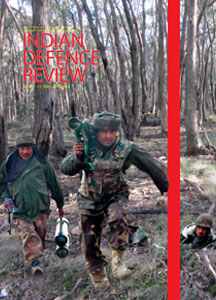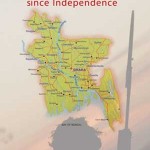Introduction
While waiting for Godot, the third character, who eventually remains unknown in this famous play by Samuel Beckett, the other two characters in Waiting for Godot, engages in a discussion on life and its experiences as shared by both. When 2017 marked the 50th year of a relatively conspicuous event in an even more conspicuous geographical location, Naxalbari, it gave the strategic community of the country time to reflect in terms of what went wrong and what could have been done, much like the characters. This conflict has been termed as the biggest internal security challenge of the country by the then Prime Minister, Dr. Manmohan Singh. At the forefront of this strategy are the counterinsurgency (COIN) policies. Among other challenges of addressing an insurgency which champions the beauty of hiding among the populace thereby making an uphill task for the security forces to attack without avoiding substantial collateral damages, is the use of Improvised Explosive Devices (IED). The Maoists remaining true to their league have been taking full advantage of the terrain wherein they reside and operate. Quite a few lives have been lost besides acting as a morale soaking sponge of the security forces in its current state of usage of IED. One of the potent ammunitions of the security forces in such a scenario is the abundant and extensive use of Mine Protected Vehicles (MPV).
Significance of MPV
An effective MPV, however, could go a long way in addressing a plethora of aspects simultaneously. Firstly, it would boost the confidence of the security personnel deployed in the area to go and perform their task without any constrain and fear. Secondly, heavy casualties are possible to be averted by such a step uplifting the morale of the armed forces which takes a dip every time such incidents happen. Last but not the least, this could act as a counter propaganda by the state challenging the Maoists who not only view every such explosion as a success but also uses it to garner support among the masses by campaigning about it.
The first and only incident of an unsuccessful attempt by the Maoiststo attack MPV happened in Narayanpur, Bastar 2005 when the rebels had used 8 kgs of TNT to target the security forces. There were, however, no news of fatalities other than rendering the MPV immobile. Having learnt their lessons, they carried out an attack on September 3, 2005 where the amount of explosives was multiplied 10 times killing 24 people, 23 CRPF personnel and a civilian driver. The death of the security forces occurs because of multiple injuries-the impact of the blast, followed by head and spinal injury and the nail in the coffin is bolted by the Naxals who ambush the security people by openly firing upon them when they try to escape from the vehicle.
Initiative by the State
It is to tackle such challenges that the Government of India (GOI) began taking initiatives to ensure safety of the security personnel.
Public Sector
The Aditya vehicle was developed by Defence Research and Development Organisation (DRDO) with know-how from Israel.
| TECHNICAL DATA | |
| Length | 6.00 M |
| Width | 2.90 M |
| Height | 3.07 M |
| Ground Clearance | 305 mm |
| Speed | 85 KMPH Max |
| Patrol Speed | 50 KMPH |
| GVW /Pay Load | 11 Tons/1400 Kgs |
| Seats | 10 + 2 |
| Range | 1000 Km |
| Fordability | 1000 mm |
| Protection Level | Mine Blast 14 Kgs TNT under wheels 10 Kgs TNT under Hull |
| Small Arms | 7.62 SLR Rifle firing from a distance of 10 meters on all sides of vehicle |
| LMG/MMG | Rotating Turret provided |
Source : Global Security
The upgraded version of Aditya is Yuktirath Mk III MPV. It was unveiled at the DEFEXPO 2012. It is designed to carry 10+2 personnel and2 tonnes of payload with gradeability of 30 degrees. It can touch a maximum speed of 85 km/hr. It can take upto 42 kgs of TNT. It is equipped with stabilised remote control weapon system facilitating its operation both in day and night. The V shaped monocoque body has windows with impact resistant glasses. The doors and the bonnets are pneumatically controlled. It also has remotely operated search lights for 360-degree operation.
Private Sector
Apart from the government initiatives, three teams headed by Indian private vehicle manufacturers Tata Motors, Ashok Leyland and Mahindra have been experimenting with MPV.
Tata Motors has supplied 5 MPV’s to the Jharkhand police and 32 to the Maharashtra police. However, it is Defence Land system India (DLSI), a joint venture of the Mahindra and the UK based BAE systems which has been more successful. It’s MPV can withstand 21 kg TNT compared to just 8 to 10 kgs of the other 2 companies. The six-wheeled MPV-I (Mine Protected Vehicle India) of the Mahindra also provides greater safety than the four-wheeled of Tata and Leyland MPVs. The special armoured steel for the MPV-I’s protective body comes from Sweden; it is built into a monocoque body using kits imported from South Africa. The engine and chassis are from Russian Ural vehicles that are manufactured at Haldia, West Bengal. Using these inputs, DLSI has the capacity to build 100-120 MPV-I per year. MPV- I has been tested in South Africa to global standards, using million-dollar mannequins (unlike earlier where tests were carried out on pigs), and found capable of protecting passengers even when subjected to a blast from 21 kilos of TNT.
Response by the Maoists
The Maoists military machine, the People’s Liberation Guerrilla Army (PLGA), is headed byNambala Kesava Rao alias Basavaraju, an M Tech from the National Institute of Technology, Warangal. This information goes on to establish to some extent that the technical department of the Maoists is in the hands of someone who has ‘sufficient’ knowledge to address issues arising out of the concerned vehicle- knowledge whose sole motif is to inflict maximum damage involving human deaths.
The police seized a Maoist military magazine, Awam-e-Jung from the Orissa-Andhra Pradesh border which revealed the Maoist tactics against the MPV. In an article titled ‘Mine-proof Vehicle — Its Shortcomings’, the Maoists identified the vulnerabilities in the MPV while advising the cadres on how to ‘handle’ it. “It is an utter lie to call it a mine-proof vehicle. The vehicle is being propagated as mine-proof to boost the morale of forces that have lost it,” the article said.
Officers such as Brigadier B.K. Ponwar who runs the Counter Terrorism and Jungle Warfare School in Kanker, Chhattisgarh, say there is no alternative to patrolling on foot in the kind of terrain the conflict is now raging. “If an MPV is designed to withstand an explosion of 8-10kg, they (the rebels) will simply stash the device with more explosives to cause damage,” one officer said. These MPVs are designed to withstand blasts of up to 14 kg of RDX, as used in conventional military landmines. But the Maoists don’t use military landmines or RDX-based IEDs. They use fertilisers, emulsions, and slurries in their IEDs, which have a heaving effect and not a shattering one which RDX produces.
The debate over MRAP:
It would be fallacious not to mention a similar kind of debate on Mine Protected Ambush Resistant (MRAP) vehicles used by the United States (US) in its Operation Iraqi Freedom and Operation Enduring Freedom in Iraq and Afghanistan respectively, thereby articulating that India may not be the only one debating over the issue. Pentagon’s Joint Program Office for Mine-Resistant Ambush Protected Vehicles (JPO-MRAP) is a $45 billion program to design, manufacture, and deploy 27,000 heavily protected vehicles into Iraq and Afghanistan. While MRAP has gone a long way in securing the lives of the forces on the ground as claimed by the then Defence Secretary Robert Gates, there are reports contrary to this popular view points as well claiming “MRAPs did not generate large reductions in fatalities beyond those achieved by the factory-armored Humvees and were not cost-effective for any unit”. However, the experts are unanimous on a couple of things related to the vehicle being that of expensive and bulky. “The Pentagon transported many MRAPs by air at a cost of more than $100,000 per vehicle — an order of magnitude more expensive than sea and ground shipping.”Pentagon had, however, expressed concern over the shipment of the vehicles back to US owing not only to the cost involved but also the sagacity of “shipping home damaged, worn or excess MRAPs to bases already deemed oversupplied with the blast-deflecting vehicles”. It is at this juncture that GOI decided to approach the US to purchase MRAP vehicles. US would rather give the defence articles to India than risk it being taken over by the Taliban post the withdrawal of the US forces from Afghanistan.
Conclusion
The question of the MPV in the case of LWE, thus, hinges on the conundrum of, to use or not to use. While one can hardly debate about the advantages of its use in a forest laden geographical location, at the same time it has been established beyond doubt that the Maoists have the potential to overcome the withstanding capacity of the vehicle against any amount of explosives used. However, it is not only India which is debating over this issue. Countries like USA with their most sophisticated weaponry have suffered substantial damages owing to mine related incidents. The debate is an ongoing one especially in COIN strategies all over the world. The actions and counteractions surrounding MPV thus makes it clear how difficult it is to address this aspect of COIN. Therefore, getting back to the beginning of the narrative we are waiting for ‘Godot’ (who, by the way, eventually never arrives), a plausible solution to the enigma of protection of the protector.






good one well , t o point out if naxals need to 42 kg explosices then its easier to detect… we need the right equipment to be desinged, while there ia no alternatives for foot …. its only a point that how far u can atke soldier on mpv to nearest point.